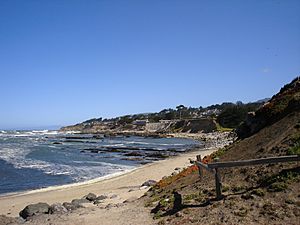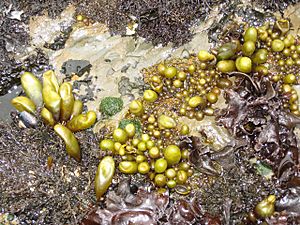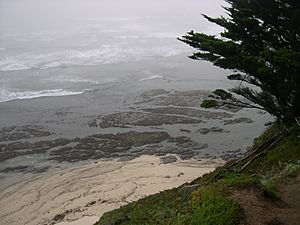Fitzgerald Marine Reserve facts for kids
Quick facts for kids Carmel Pinnacles State Marine Reserve |
|
|---|---|

Tidepool and anemones, Fitzgerald Marine Reserve
|
|
| Lua error in Module:Location_map at line 420: attempt to index field 'wikibase' (a nil value). | |
| Established | 1969 |
| Governing body | California Department of Fish and Game |
The Fitzgerald Marine Reserve is a special ocean area in California. It's located right on the Pacific Ocean, just north of Pillar Point Harbor and Mavericks. You can find it in the town of Moss Beach in San Mateo County. Moss Beach is about 20 miles (32 km) south of San Francisco and 50 miles (80 km) north of Santa Cruz.
This reserve is a 32-acre (0.13 sq km) area. It stretches from the Montara light station in the north to Pillar Point in the south. The reserve includes a three-mile (4.8 km) stretch of beach, amazing tidepool areas, a marsh, and tall cliffs. There's also a trail along the clifftop and forests with cypress and eucalyptus trees.
The State of California owns the land, but San Mateo County manages it. It's like a county park and a nature preserve. The reserve is also part of the larger Monterey Bay National Marine Sanctuary. Sometimes, a rare butterfly called the San Bruno elfin butterfly is seen near or inside the reserve.
Just offshore from Montara, north of Pillar Point, are the Montara State Marine Reserve and Pillar Point State Marine Conservation Area. These are like underwater parks. They help protect ocean animals and their homes. Fitzgerald Marine Reserve is actually inside the Montara State Marine Reserve.
Contents
History of Fitzgerald Marine Reserve
The area where Fitzgerald Marine Reserve is today was first settled by Native Americans about 5,800 years ago. They lived here long before anyone else.
In 1908, the Ocean Shore Railroad came through Moss Beach. This made the area a popular place for tourists to visit. You can still find parts of old foundations and gardens from homes built in the early 1900s on the cliffs above the reserve.
For a long time, scientists and collectors came to this site to study and gather marine life. So many people visited that in 1969, San Mateo County asked California to protect the area. They wanted to save the plants (flora) and animals (fauna) that lived there. On August 5, 1969, the site officially became a state reserve. It was named after James V. Fitzgerald, who was a mayor of San Bruno and a long-time member of the San Mateo County Board of Supervisors.
Amazing Nature at the Reserve
The tidepool area at Fitzgerald Marine Reserve is known as one of the best in northern California. The State of California has even called it one of 34 coastal areas with "Special Biological Significance." This means it's super important for nature!
In the tidepools, you can see many cool creatures. Look for Sea urchins, anemones, hermit crabs, and many other animals that live between the high and low tide lines.
At the north end of the reserve, San Vicente Creek flows into the Pacific Ocean. This creek area has different plants like Red Willow trees. If you cross a small footbridge over the creek, you can climb up to the bluff trail. This trail is about 100 feet (30 meters) above the beach. From here, you get amazing views of Frenchmans Reef, which is a rich area for ocean life. The reserve also extends far out into the ocean, reaching depths of over 1,000 feet (300 meters). The reef itself is made of a rock called granodiorite.
A very rare plant called Hickman's potentilla was seen near San Vicente Creek in 1933. For many years, no one saw it again. But then, another group of these plants was found north of Moss Beach. This plant is now listed as an endangered species by the United States government. California also listed it as endangered in 1973.
The endangered San Bruno elfin butterfly has been spotted near the reserve in Montara. This butterfly lives in a very small area and needs specific plants to survive.
The Seal Cove Fault is an active crack in the Earth's crust. It forms much of the eastern edge of the reserve. Scientists believe this fault connects to the larger San Andreas Fault further north. You used to be able to see the fault line clearly in the sea cliff, but now it's harder to spot.
Different Habitats to Explore
The reserve has several different types of natural homes, called habitats.
- Coastal Strand: This area is between the ocean and the upper beach or marsh. Many animals love this spot. You might see California sea lions, harbor seals, Snowy egrets, Great blue herons, and many types of cormorants, terns, murres, and gulls. In the tidepools, there are sea urchins, anemones, hermit crabs, and lots of other shellfish.
- Salt Marsh: The sides of San Vicente Creek and another small creek are coastal salt marshes. This is a very important place for many birds to nest and find food, including rails. The thick pickleweed plants here also provide good homes for rodents, reptiles, and rabbits.
- Freshwater Marsh: North of the salt marsh, there's a freshwater marsh with small springs. This area has many trees that are important for birds and mammals. The arroyo willow trees here are especially helpful for migrating warblers and other small birds.
Nearby Fun Places
At the southern edge of the reserve, you'll find the Moss Beach Distillery. This building is a California Point of Historical Interest. It has been a restaurant on the cliffs since 1927.
East of the reserve is the Seal Cove Inn. This is a fancy hotel run by a famous travel writer named Karen Brown.
Did you know? The beginning of the movie Memoirs of a Geisha was filmed on the bluffs overlooking the reserve!




